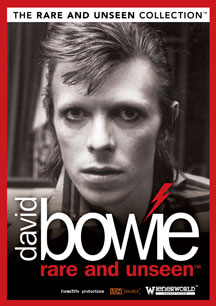
MVD Visual’s Rare and Unseen series takes an archeologist’s view, unearthing skeletons and scraps from media storage lockers and assembling unauthorized but fan-centric views of various artists. This David Bowie collection leads with a 1976 interview previously unaired in the States, conducted via then-sketchy satellite technology by British presenter Russell Harty. Though there are softball questions aplenty concerning topics such as the color of Bowie’s hair, it’s interesting to see Bowie in the process of reinvention as a musical force following his glam phase and subsequent sojourn in Hollywood as a film actor making The Man Who Fell to Earth. During a more modern interview clip circa Earthling, Bowie claims that his consumption of mind-altering substances during his Ziggy Stardust period was such that he didn’t necessarily realize he was playing characters. Hollywood must have seemed like a natural fit.
As an unauthorized snapshot, song segments are performed by an imitator. Acoustic versions of favorites like “Ziggy Stardust,” “Changes,” Drive in Saturday,” “Life on Mars?” and “Oh You Pretty Things” are performed by mimic Stevie Riks. This tactic, it must be said, comes across as a cheat. Perhaps something deliberately unique but compelling would have made a better impression, along the lines of Seu George‘s solo versions sung in Portuguese throughout filmmaker Wes Anderson‘s The Life Aquatic with Steve Zissoui. Early archival video clips from concert performances are sprinkled throughout the film, matched to further outsourced audio. Footage from the Glass Spider Tour supporting Never Let Me Down does include snatches of rehearsal and performance with original audio, along with interview segments featuring longtime bandmate Carlos Alomar and childhood friend/Glass Spider guitarist Peter Frampton.
Although Julian Temple is interviewed regarding his work with Bowie on the “Jazzin’ for Blue Jean” video, there are no official promotional concept videos aside from a brief clip of “China Girl” – again with Riks’ audio accompaniment. This pervasive approach doesn’t lend much in the way of credibility to the overall film, but those who are interested in glimpses at the mind behind the music can appreciate and enjoy the documentary approach, particularly the interview segments with Bowie himself (which predominate).
All things considered, as a pretty big Bowie fan myself, I’m still glad the film exists and that I watched it for those fresh Bowie tidbits. Bowie’s opinion appears to be that such fans are missing the point. “I’m always amazed that people take what I say seriously,” the artwork quotes him as saying. “I don’t even take what I am seriously.”